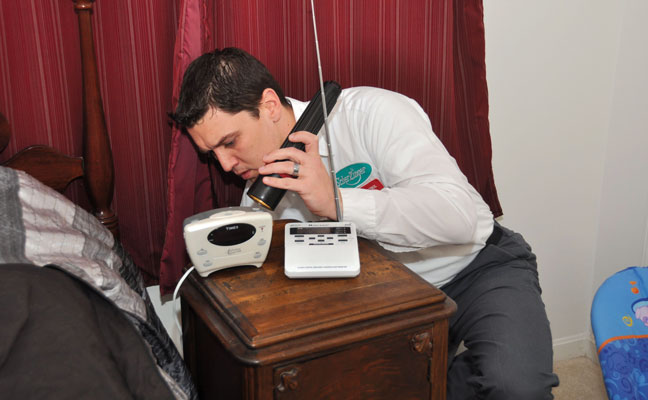
Illustration: Leo Michael
Who doesn’t love a little controversy? We certainly do. That’s why we pitted our “Face-Off” columnists — Scherzinger Termite & Pest Control’s VP of Sales & Marketing, Eric Scherzinger, and his brother, VP of Operations Kurt Scherzinger, ACE — against each other, knowing their Cincinnati, Ohio-based firm uses both bed bug treatment methods: heat, which they often follow up with a chemical application for residual control, and chemical. Although plenty of bed bug management options exist, this debate explores the differences between heat and chemical treatments for bed bugs. Let the debate begin! — The Editors
Read the other side: “AN APPEAL FOR HEAT TREATMENT” by Kurt Scherzinger
AN APPEAL FOR TRADITIONAL TREATMENT
By Eric “Cold Miser” Scherzinger, PMP Contributor
When our great-grandfather, B.C. Scherzinger, founded Scherzinger Termite & Pest Control in 1934, he managed bed bugs — with chemicals. It worked back then, and it works now. Plus, we treat for bed bugs in a much more precise and targeted manner than Great Grandpa did. We also have a leg up over the do-it-yourselfer (DIYer) who applies mounds of dust around the edges of their rooms, thinking that the bed bugs will just walk through it and die. I mean, a label means nothing to a DIYer.
I’m just going to come right out and say it: Traditional treatments by a pest management professional (PMP) work. Unlike heat, a large investment in equipment and labor, including labor for equipment maintenance and breakdowns, is unnecessary. Extra labor costs are not a factor because traditional treatments require only one technician, as opposed to two for heat treatments. Our grandfather and our dad used chemical treatments for bed bugs for decades — the instances were rare, but they did occur. Their treatment delivered results.
Besides, chemicals are our main line of defense for the other insects we manage. Why should bed bugs be any different?
The heating process seems to cost more to accomplish the same goal of eliminating bed bugs. Why would a customer want to invest all this money, only to have to pay a larger maintenance bill — rather than taking care of a few tools needed for traditional chemical service? It seems like a waste.
Not only that, but it’s often recommended to apply a post-treatment residual. You are telling me that I still have to treat with the traditional method while doing heat? That seems counterproductive and inconvenient. If that’s the case, why not just use the traditional method from the beginning? This seems to merely add more costs to the total bed bug treatment package.

PHOTO: iStock.com/pagadesign
The liability factor
Another issue that arises with heat that doesn’t with a traditional bed bug treatment is removing certain items from the property so they don’t melt or otherwise ruin. This seems like a huge liability gamble. Are we really asking employees to go through the customer’s personal belongings? Are we really asking customers to be OK with that? I remember seeing some crazy things and scratching my head when I was a technician providing service, and that was without trying to remove anything from the premises before treatment.
Even if we get the customer on board with that, we might lose them to sticker shock. Not everyone can afford heat treatments, so we must make other options available. We have had success with traditional bed bug treatments over the years.
No matter which treatment we offer — and we offer heat and chemical — we need to ensure that we continue to hire detail-oriented technicians who treat where bed bugs are most likely to hide and harbor.
The science behind traditional treatment
The U.S. Environmental Protection Agency (EPA) has registered more than 300 products for use against bed bugs, both at the consumer and professional levels. They fall into seven chemical classes of pesticides that currently are registered and widely used for bed bug control:
1. Pyrethrins are botanical insecticides derived from chrysanthemum flowers.
2. Pyrethroids are synthetic chemical insecticides that act like pyrethrins. Both compounds are lethal to bed bugs, and can flush bed bugs out of their hiding places and kill them.
3. Desiccants work by destroying the waxy, protective outer coating on a bed bug. Once this coating is destroyed, the bed bugs will slowly dehydrate and die.
4. Cold pressed neem oil is the only biochemical pesticide registered for use against bed bugs. The oil, derived from seeds of the Neem tree, contains various compounds that have insecticidal and medicinal properties.
5. Chlorfenapyr is the only pyrrole pesticide currently registered for use against bed bugs. The compound is a pro-insecticide — that is, the biological activity depends on its activation to form another chemical. The new chemical disrupts certain functions in the bed bug’s cells, causing its death.
6. Neonicotinoids are synthetic forms of nicotine. They act on the nicotinic receptors of the nervous system by causing nerves to fire continually until they fail.
7. Insect growth regulators (IGRs) are chemicals that mimic juvenile growth hormones in insects. They work by either altering the production of chitin (the compound insects use to make their hard external “shells,” or exoskeletons) or by altering an insect’s development into adulthood. Some IGRs force the insects to develop too rapidly, while others stop development.
An additional chemical class also is registered for a very narrow use pattern. Dichlorvos (also known as DDVP, an organophosphate) is registered as a pest strip for the treatment of small enclosures.
SOURCE: EPA.gov/bedbugs/pesticides-control-bed-bugs

PHOTO: Scherzinger Termite & Pest Control
5 reasons chemical is cool
- Chemical treatments cost less than typical heat treatments.
- Heat alone typically will not give 100 percent elimination, so chemical comes to save the day.
- Labor is less intensive than for typical heat treatments.
- Technicians need no additional equipment training than what they’ve received already for general pest control, and thus are more versatile for routing.
- The technician a customer is used to seeing for ants, rodents, etc., is the same for the bed bug service, which can
be reassuring to the customer.
Read the other side: “AN APPEAL FOR HEAT TREATMENT” by Kurt Scherzinger
Brothers Eric and Kurt Scherzinger are vice president of sales and marketing and vice president of operations, respectively, for Scherzinger Termite & Pest Control based in Cincinnati. The fourth-generation pest management professionals can be reached at eric@stopzbugs.com and kurt@stopzbugs.com.
Leave A Comment